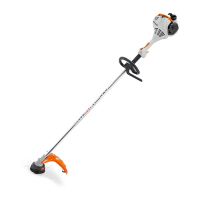
Do you have a question about the Stihl FS 55R and is the answer not in the manual?
| Displacement | 27.2 cc |
|---|---|
| Power Output | 0.75 kW |
| Engine Power | 1.0 bhp |
| Fuel Capacity | 0.33 L |
| Fuel Tank Capacity | 0.33 L |
| Starter System | Recoil |
| Cutting Diameter | 420 mm |
| Overall Length | 1.7 m |
| Shaft Type | Straight |
| Cutting Width | 23 cm |
| Engine Type | 2-stroke gasoline engine |